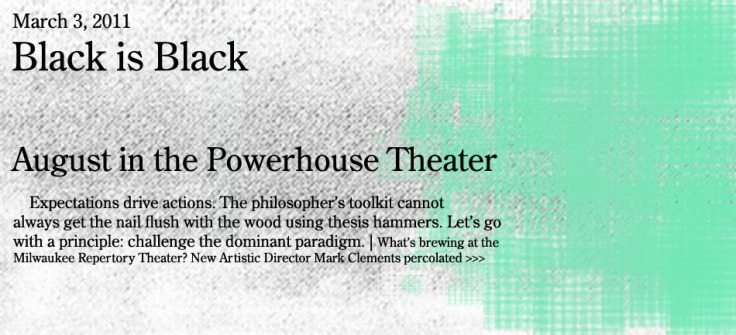
What’s brewing at the The Milwaukee Repertory Theater? New Artistic Director Mark Clements percolated several productions so far this season providing a full-bodied experience, although possibly slightly acerbic to some palates. Despite the immediate impression on the drinker’s taste, as all good cups do, your metabolism gets agitated even if by placebo. However, Clements’ is not serving any decaff at The Rep.
Unlocking an African-American contribution to theatre arts, on the first day after Black history month, created a pleasantly surprising buzz of Powerhouse Theater regulars and patrons with specific interest in play-write August Wilson’s work. The production, Ma Rainey’s Black Bottom, incarnated a story dramatizing an episode of renowned Blues singer Ma Rainey’s career as a musician. Set in a Prohibition-era Chicago recording studio, the audience meets producers Irving and Sturdyvant and soon after make acquaintances with Rainey’s band (Slow Drag, Levee, Cutler and Toledo). Similar to overhearing gossip, the producers and the band dish a little on Ma Rainey, appetizing the viewers for her entrance. Drama unfolds as beguiling antics wrought with the lively mundane banter of old colleagues and band-mates keeps the audience off-guard, for unanticipated moments when deeper social commentary arise.
The Mirror
Written in 1982, Wilson’s Ma Rainey’s Black Bottom capture stereotypes that border on truth for all parties involved. The play’s characters embody racial archetypes and tell a story we have heard before: injustice, exploitation, abuse, irreverence and self-destructive; long-suffering, under achieving, intelligent, god-fearing and forgiving. What the audience gets to witness is the personified interaction of these forces in time-lapse and in social proximity that does not normally occur on a daily basis. In genius form, Wilson weaves into commonly accepted narratives of America’s historical social tragedy insightful and unexpected commentary on social norms scathing to both whites and blacks.
The dialog on stage may make some uncomfortable or embarrassed. From the beginning of the production, lack of social progress is apparent more in the Black social-sphere than in American society. Taking into account when he authored the play, Wilson elicits this moral of the story, with intention, purposefully and skillfully. To his credit, Wilson’s balances his narrative whether it be the accounts of wrong doing against blacks perpetrated by whites or seeing black stereotypes hit close to home. Wilson makes his audience address these issues with presence of others. When blacks and whites share the house the technique is particularly powerful.
I Ain’t the One, I Ain’t the N***A
The “N-word” has prominence in the vocabulary of the black characters. In light of the recent controversy over editing the “N-word” out of Mark Twain’s Huckleberry Finn, it was encouraging to note that as difficult as it is to hear, director OJ Parson includes the term. Most importantly, the connotation used in the play is not endearing.
Conspicuously, the white characters don’t use the term in situations where one might expect the word’s use by a white person, during a time when racism was more aggressive and overt. The deliberate lack of usage of the “N-word” by white characters may imply, to critical thinkers, that there is some risk of losing the origin of the word’s usage. If white characters do use it in the play as Wilson wrote it, to edit those exchanges out of the script gives the production a revisionist interpretation at the mercy of people’s sensibilities. It is important that we move past this period in American history. However, in thought provoking literary work, confronting realities should not come at the expense of sensibilities. Pardon the editorial, but should we edit diseased authors’ works to fit our tastes?
Keeping it 100
Ma Rainey’s Black Bottom leaves the audience fully entertained, enlightened and frankly impressed. Quality set design and stage direction lay the foundation for this work. Ma Rainey’s Black Bottom settles old scores, like who founded the woman’s voice in American Blues Ma Rainey or Bessie Smith. Some issues Wilson leaves unresolved as the play comes to an abrupt end. One must also ask why some things just don’t seem to change. Wilson assigns that question as homework. If not for anything else, hearing the cast utter the super cool nicknames of the band is worth the price of admission. Ma Rainey’s Black Bottom opened March 1, 2011 and closes March 27, 2011.

Leave a comment